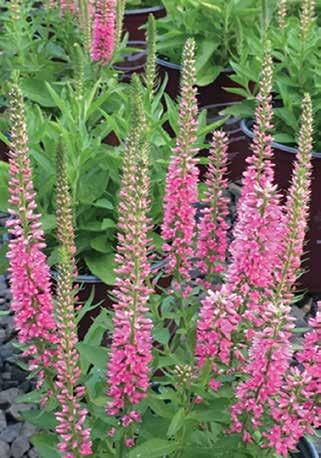
27 minute read
New Plants in 2017
2017 | NEW PLANTS
BLOOMING NURSERY www.bloomingnursery.com
Advertisement
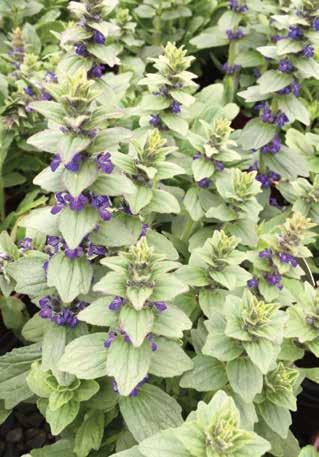
Veronica longifolia Vernique Series: ‘Rose’ & ‘White’
New and improved, Vernique Rose and Vernique White are well branched, have tight, compact habits and rich, long lasting spikes of color in abundance from spring to early fall. This breakthrough Veronica is perfect for the border, the cutting garden and for mixed containers. Excellent mildew and leaf spot resistance makes this delightful perennial easy to grow and appreciate. These are some of the best of the many new Veronicas now coming into the market! Attract hummingbirds and deer resistant. Hardy in USDA zones 4-8; 12-18” Tall x 10-12” Wide.
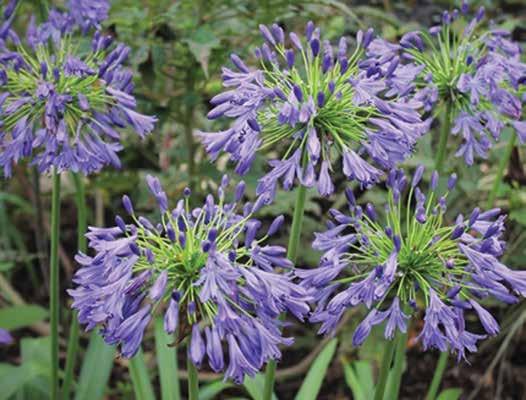
Ajuga genevensis Blue Bugleweed
Ajugas are not just for groundcover, anymore! This is a true border perennial, and quite striking once established. Not invasive like other Ajugas, as it is not stoloniferous. Native to the edges of forests and woods of Britain and parts of Europe it works well near the front of borders and in rockeries. Blue Bugle flowers from mid-April through July, with profuse dense spikes of relatively large bright blue flowers. It’s evergreen and hardy, possibly to USDA zone 3 and maintains an evergreen presence. Grows well in full sun or bright shade and will get 12-14” tall and around 2’ wide.
Agapanthus ‘Stevie’s Wonder’
Stevie’s Wonder offers a bold presence, whether as a long-blooming dramatic specimen in the perennial border, the large rock garden, poolside or in large containers. This Lily-of-the-Nile has large, (3 ½-4”!) umbels of rich blue-purple, trumpet-shaped blooms from summer to fall. The 30-36” tall flowering stalks arise from vigorous flat-leaved neat clumps. Agapanthus is deer-resistant, but well loved by hummingbirds and bees. It’s also good as a cut flower, offering beautiful vivid blue shades and lots of flowers per stem! Hardy in USDA zones 7 – 10.
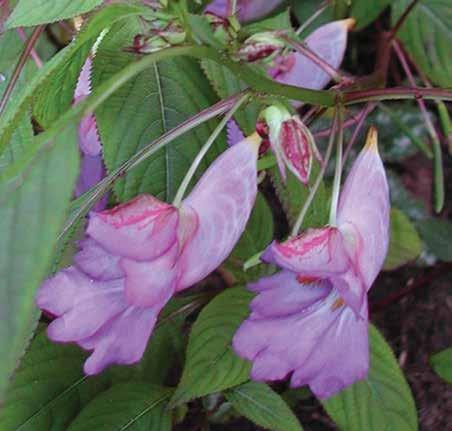
Impatiens arguta ‘Blue Dream’
A flamboyant lavender blue flower distinguishes this hardy shade stunner. Blue Dream seems to be in bloom most of the year! The flowers are very exotic looking, and the foliage neat and elegant. 2’ X 2’.
Trachelium caeruleum ‘Dark Purple’
Large dome-shaped flower heads like dark purple clouds of fragrant blooms are a favorite among butterflies and bees. Dark, nearly black stems and deep purple cast foliage complement the lovely, fluffy domes. An eye- catching component in containers and any border. Trachelium also is an excellent cut flower. Remove spent flowers for continuous bloom from summer to frost. Hardy in USDA zones 8 – 10. 20” Tall/Wide
Iberis gibraltarica ‘Lavish’
Masses of sparkling multi-shaded lavender blooms spring through summer cover this breakthrough Candytuft. It’s vigorous and naturally well-branched and the shades from white to warm lavender make it shine. This variety exhibits better cold hardiness than the species, too! Butterflies love it. Deer don’t! It’s drought tolerant, and hardy in USDA zones 7a -10b. Grows 10-12” Tall and 16” Wide. Don’t forget to fertilize it; Candytuft in general are relatively heavy feeders.
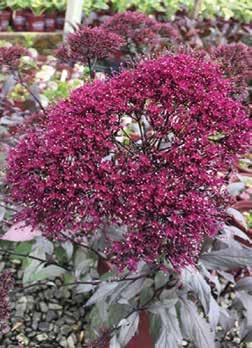
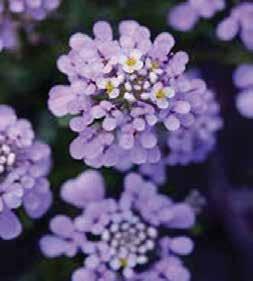
Ellisiophyllum pinnatum
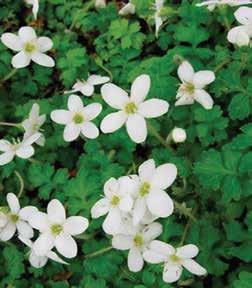
Ellisiophyllum pinnatum is a pleasing, mat-forming, evergreen groundcover that loves semi- to fully shady places. This workhorse looks like anything but: pretty, fine textured foliage just 2-3” tall, spreading up to three feet wide to create a virtually weed-proof mat covered in summer with bright white star-shaped flowers. This is a new go-to no maintenance option for moist, well-drained shady shrub beds, borders, ponds, stream banks, rock gardens, as well as for hanging baskets and combination planters. Native to India, Taiwan and Japan. Hardy in USDA zones 7 – 9.
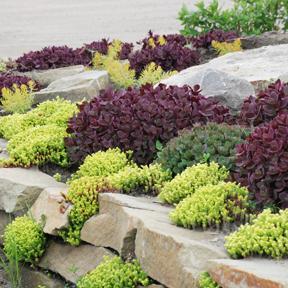
Sedum SunSparkler ‘Firecracker’
shines in the garden with its cherry-red foliage from April thru November. This attention-grabbing sedum forms 6”tall mounds of colorful foliage with exceptional multi-branching, which combines superbly with other drought tolerant perennials. ‘Firecracker’s compact habit also allows for a multitude of uses including mixed container plantings, edging, ground cover, and green roof gardens. Spread 18” Zone 4.
Sedum SunSparkler ‘Firecracker’ shines in the garden with its cherry November. This attention-grabbing sedum forms 6”tall mounds of colorful foliage 2017 | NEW PLANTSexceptional multi-branching, which combines superbly with other ‘Firecracker’s compact habit also allows for a multitude of uses including mixed container T&L NURSERY Sedum SunSparkler ‘Wildfire’ has shiny, cherry-red succulent foliage with hot pink variegated edges. This sensational Sedum is multibranching to form colorful, low-growing clumps. The vibrant foliage www.tandlnursery.com The unique gold foliage of Lithodora GOLD 'N SAPPHIRES ™ makes a beautiful contrast to the blue flowers in spring The bright foliag e stays attractive all summer long, has excellent vigor, and does well in the s un. This drought tolerant perennial grows to about 4in. by 18in. G reat accent for sunny banks, in rock gardens, or cascading over a wall. Zone 6 plantings, edging, ground cover, and green roof gardens. Spread 18” Zone 4 ------------------------------------------------------------------------------------------------------------------------------Sedum SunSparkler ‘Firecracker’ shines in the garden with its cherry November. This attention-grabbing sedum forms 6”tall mounds of colorful foliage lasts all season long, and eventually takes on a pumpkin-orange fall color. Very compact plant with tight clusters of dark pink flowers in late exceptional multi-branching, which combines superbly with other summer. Use this drought tolerant Sedum in borders, containers, or as a ‘Firecracker’s compact habit also allows for a multitude of uses including mixed container ground cover. Ht. 6in, Spread 18in. Zone 4. plantings, edging, ground cover, and green roof gardens. Spread 18” Zone 4 The unique gold foliage of Lithodora GOLD ‘N SAPPHIRES™ makes a beautiful contrast to the blue flowers in spring. The bright foliage stays attractive all summer long, has excellent vigor, and does well in the sun. This drought-tolerant perennial grows to about 4in. by 18in. Great accent for sunny banks, in rock gardens, or cascading over a wall. Zone 6. Carex ‘Feather Falls’ is a vigorous, variegated Carex that will work in almost any landscape situation. This evergreen grass shows its versatility by tolerating full sun conditions without burning, while thriving in shady conditions as well. ‘Feather Falls’ gets its name from the lovely feather-like seed heads in spring that contrast beautifully against the green and cream foliage. This Carex has it all! Zone 5 Grows 12”-18” tall by 18”-24” wide.
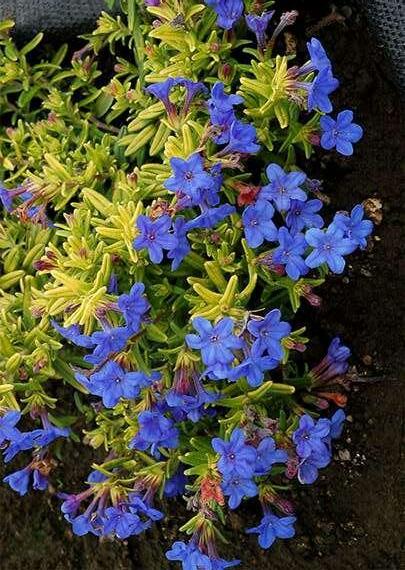
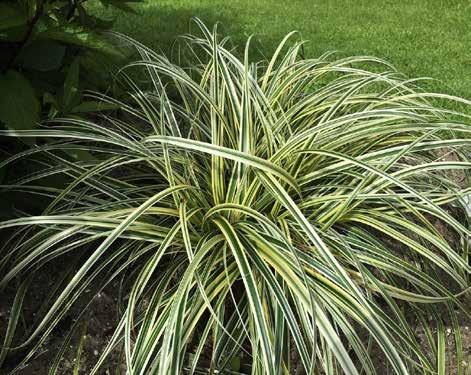
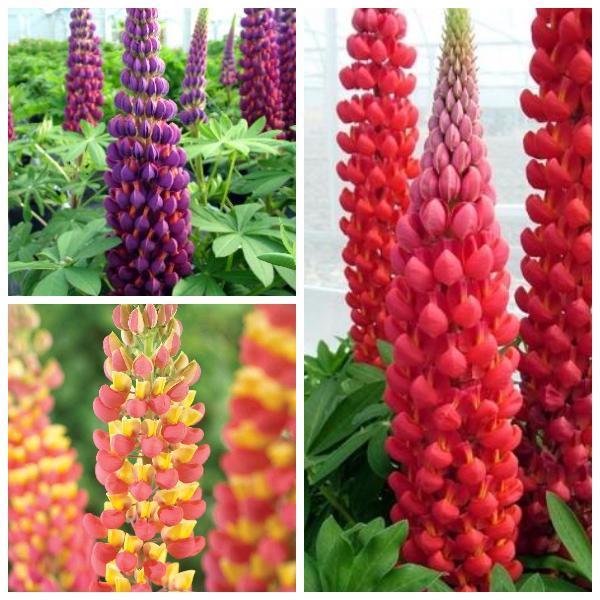
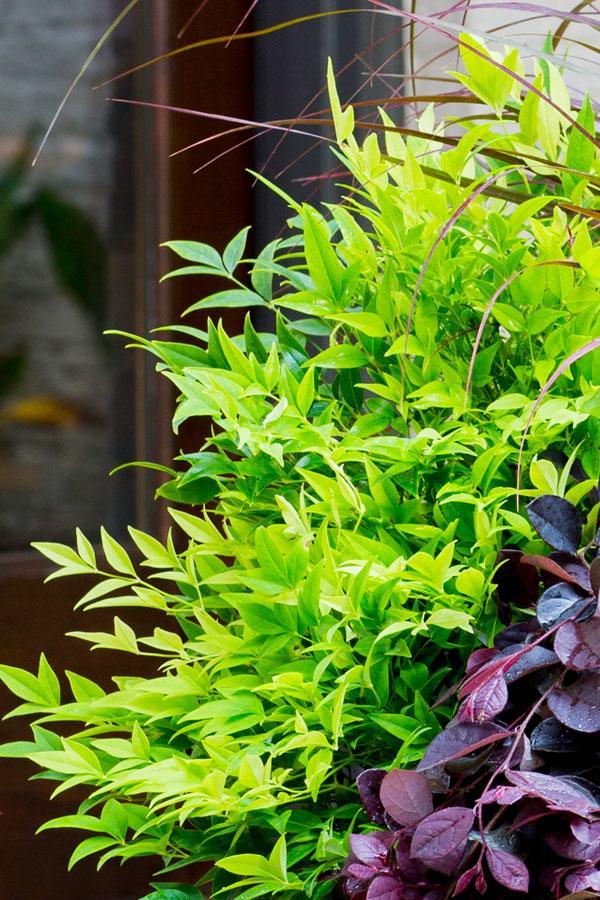
Lupinus Westcountry. This new series has been microLupinus Westcountry. -propagated for improved uniformity and Nandina ‘Lemon Lime’ stands out from all other Nandinas by having bright, lime green new growth! The new foliage eventually fades to a nice green, and will not turn red over the winter. vigor! Westcountry lupines come in a rainbow of colors including ‘Masterpiece’, ‘Red Rum’, and ‘Gladiator’ (pictured top left, right, and bottom left). The tall flower spikes bloom early summer every year, and if pruned back, often followed by a second blooming later on. Plant several This new series has been micro-propagated for improved uniformity and vigor! Westcountry lupines come in a rainbow of colors including Use this evergreen shrub to brighten up any spot in the full sun to partcultivars in a sunny perennial border for a kaleidoscope effect! Ht. 24in.-36in. Zone 4 ‘Masterpiece’, ‘Red Rum’, and ‘Gladiator’ (pictured top left, right, and -shade garden. This versatile selection can be used ibottom left). The tall flower spikes bloom early summer every year, n borders, containers, as a hedge, or even as greenery in cut flowers arrangement. Ht. 3and if pruned back, often followed by a second blooming later on. -4ft Zone 6
Plant several cultivars in a sunny perennial border for a kaleidoscope effect! Ht. 24in.-36in. Zone 4. Nandina ‘Lemon Lime’ stands out from all other Nandinas by having bright, lime green new growth! The new foliage eventually fades to a nice green, and will not turn red over the winter. Use this evergreen shrub to brighten up any spot in the full sun to part-shade garden. This versatile selection can be used in borders, containers, as a hedge, or even as greenery in cut flowers arrangement. Ht. 3-4ft
Zone 6. ‘Peppermint Pearl’ is an enchanting evergreen plant with berries white as pearls! The large berries eventually mature to pink adding even more interest to this new plant. Glossy, dark green foliage and white flowers in summer. Nice and tidy with a low spreading habit. Ht. 4-6in, Zone 4.
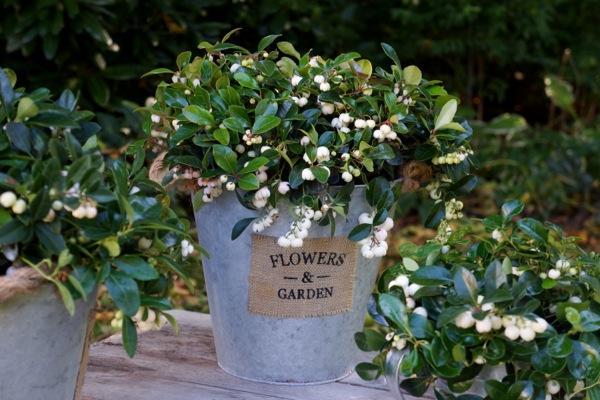
2017 | NEW PLANTS
CHRISHAVEN TREES www.chrishaventrees.com
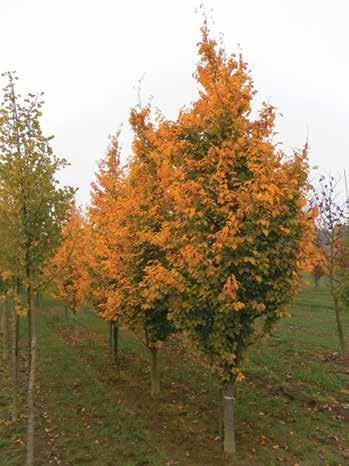
Parrotia persica ‘Golden BellTower’ (PPAF)
An outstanding new tree which holds considerable merit for the landscape industry. It was discovered over 20 years ago amongst a large population of Parrotia persica (Persian Ironwood) which we were growing here at the Chrishaven Trees farm. We have named this new cultivar ‘Golden BellTower’ (PPAF).
This is a plant you really need to check out! It is definitely catching the eye of other professionals, being awarded the Judge’s Plant of Merit Award at the 2015 Farwest Nursery Show in Portland.
If you are not familiar with Parrotia persica then please take our word that it is a plant that merits attention. True, the species as a whole has suffered from lack of uniformity and refinement which has placed it at odds for many of today’s urban landscapes. ‘Golden BellTower’ addresses these concerns with its strong apical dominance and narrow growth habit, assuring a consistent and uniform cultivar with a brilliant golden-apricot fall display. Unlike some of the ‘vaseshaped’ specimens now in the trade, ‘Golden BellTower’ retains its tight flame shape crown as it ages. An added bonus is that we find it to be a strong grower in our nursery, establishing early size but not exceeding expected parameters as it ages.
Caliper trees are available at our nursery (360) 757-8996 and liners may be sourced from Heritage Seedlings & Liners or Handy Nursery Company, both in Oregon.

Bugs & Blights
TARGET THE PEST; PROTECT THE REST.Bugs and Blights Sharon J. Collman Bugs and Blights Sharon J. Collman BY SHARON COLLMAN | WSU SNOHOMISH COUNTY EXTENTION collmans@wsu.edu collmans@wsu.edu
Many cutworms hatch and start feeding in early winter. They continue to feed into spring, then pupate in the soil and emerge as drab moths in early summer. Note the 5 prolegs (fleshy back false legs used for gripping in a windstorm identify it as a moth caterpillar). The head end is pointing down and the small true legs are visible.
It took many years to finally catch this winter-active Many cutworms hatch and start feeding in early winter. caterpillar. Damage is often visible in spring but the They continue to feed into spring, then pupate in the culprit was nowhere to be found. This is unidentified soil and emerge as drab moths in early summer. Note but likely related to cutworms. By the time customers the 5 prolegs (fleshy back false legs used for gripping in find damage, this bad-boy is long gone. Similar damage a windstorm identify it as a moth caterpillar). The head is also found on salal. end is pointing down and the small true legs are visible.
Many cutworms hatch and start feeding in early winter. They It took many years to finally catch this winter-active continue to feed into spring, then pupate in the soil and emerge caterpillar. Damage is often visible in spring but the as drab moths in early summer. Note the 5 prolegs (fleshy back false legs used for gripping in a windstorm identify it as a moth culprit was nowhere to be found. This is unidentified caterpillar). The head end is pointing down and the small true but likely related to cutworms. By the time customers legs are visible. find damage, this bad-boy is long gone. Similar damage is also found on salal.
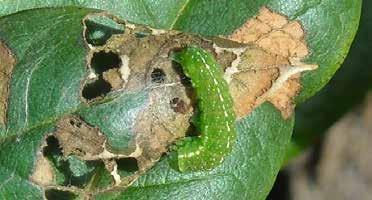
Many cutworms hatch and start feeding in early winter. They continue to feed into spring, then pupate in the emerge as drab moths in early summer. Note the 5 prolegs (fleshy back false legs used for gripping in a windstorm identify it as a moth caterpillar). The head It took many years to finally catch this winter-active caterpillar. end is pointing down and the small true legs are visible. Damage is often visible in spring but the culprit was nowhere to be found. This is unidentified but likely related to cutworms. By the time customers find damage, this bad-boy is long gone. Similar damage is also found on salal.
It took many years to finally catch this winter caterpillar. Damage is often visible in spring but the culprit was nowhere to be found. This is Many cutworms hatch and start feeding in early winter. They continue to feed into sp but likely related to cutwormsring, then pupate in the . By the time customers soil and emerge as drab moths in early summer. Note the 5 prolegs (fleshy back false legs used for find damage, this badgripping in -boy is long gone. a windstorm identify it as a moth caterpillar is also found on). The head salal. end is pointing down and the small true legs are visible.
Many cutworms hatch and start feeding in early winter. They continue to feed into spring, then pupate in the soil and emerge as drab moths in early summer. Note the 5 prolegs (fleshy back false legs used for gripping in a windstorm identify it as a moth caterpillar). The head It took many years to finally catch this winterend is pointing down and the small true legs are visible. caterpillar. Damage is often visible in spring but the culprit was nowhere to be found. This is unidentified but likely related to cutworms. By the time customers find damage, this bad-boy is long gone. Similar damage is also found on salal.
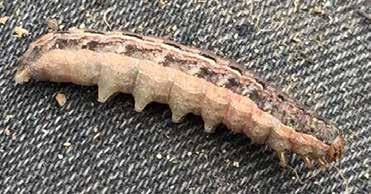
It took many years to finally catch this winter-active caterpillar. Damage is often visible in spring but the Many cutworms hatch and start feeding in early winter. culprit was nowhere to be found. This is unidentified They continue to feed into spring, then pupate in the but likely related to cutworms. By the time customers soil and emerge as drab moths in early summer. Note find damage, this bad-boy is long gone. Similar damage the 5 prolegs (fleshy back false legs used for gripping in is also found on salal. a windstorm identify it as a moth caterpillar). The head end is pointing down and the small true legs are visible. It took many years to finally catch this winter-active caterpillar. Damage is often visible in spring but the culprit was nowhere to be found. This is unidentified but likely related to cutworms. By the time customers find damage, this bad-boy is long gone. Similar damage is also found on salal.
This freeze damaged Heuchera should recover. Leaves may turn brown and crispy but if the stem hasn’t frozen it will revive to bloom another day. Cut off and brown leaves and hope for an early spring. In colder areas, the freeze may not have been so kind. This little leaf miner has been around for years but rarely causes extensive damage. The diversity in home landscapes may provide a habitat for parasitoids that keep it in check. The wavy line between dark and light green is a skinny little mine. It may have skirted along the margin and caused the brown area at the tip. Pick off objectionable leaves.
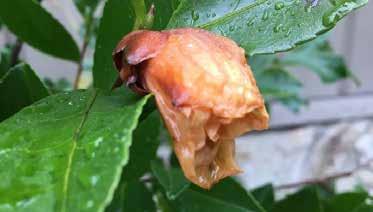
This freeze damaged Heuchera should recover. Leaves may turn brown and crispy but if the stem hasn’t frozen it will revive to bloom another day. Cut off and brown leaves and hope for an early spring. In colder areas, the freeze may not have been so kind. Leaf spot fungi love salal. An OSU study of these leaf spots revealed a lot of fungi are thriving on salal. Even so by spring, in the wild and in gardens, salal looks better as the spring advances and new growth covers
reeze damaged Heuchera should recover. Leaves This little leaf miner has been around for years but rown and crispy but if the stem rarely causes exhasn’t frozen tensive damage. The diversity in home it will revive to bloom another day. Cut off and brown landscapes may provide a habitat for parasitoids that keep it in check. The wavy line between dark and light leaves and hope for an early spring. In colder areas, the green is a skinny little mine. It may have skirted along freeze may not have been so kind. the margin and caused the brown area at the tip. Pick off objectionable leaves. Leaf spot fungi love salal. An OSU study of these leaf spots revealed a lot of fungi are thriving on salal. Even
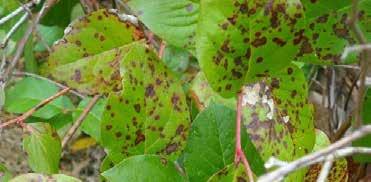
This freeze damaged Heuchera should recover. Leaves may turn brown and crispy but if the stem hasn’t frozen it will revive to bloom another day. Cut off and brown leaves and hope for an early spring. In colder areas, the freeze may not have been so kind. This little leaf miner has been around for years but rarely causes extensive damage. The diversity in home landscapes may provide a habitat for parasitoids that keep it in check. The wavy line between dark and light green is a skinny little mine. It may have skirted along the margin and caused the brown area at the tip. Pick off objectionable leaves.
This freeze damaged Heuchera should recover. Leaves may turn brown and crispy but if the stem hasn’t frozen it will revive to bloom another day. Cut off and brown This freeze damaged Heuchera should recover. Leaves may turn leaves and hope for an early spring. In colder areas, the This little leaf miner has been around for years but rarely causes brown and crispy but if the stem hasn’t frozen it will revive to freeze may not have been so kind. extensive damage. The diversity in home landscapes may bloom another day. Cut off and brown leaves and hope for an provide a habitat for parasitoids that keep it in check. The wavy early spring. In colder areas, the freeze may not have been so line between dark and light green is a skinny little mine. It may kind. This little leaf miner has been around for years but have skirted along the margin and caused the brown area at the tip. Pick off objectionable leaves. rarely causes extensive damage. The diversity in home landscapes may provide a habitat for parasitoids that keep it in check. The wavy line between dark and light green is a skinny little mine. It may have skirted along the margin and caused the brown area at the tip. Pick off objectionable leaves. Leaf spot fungi love salal. An OSU study of these leaf spots revealed a lot of fungi are thriving on salal
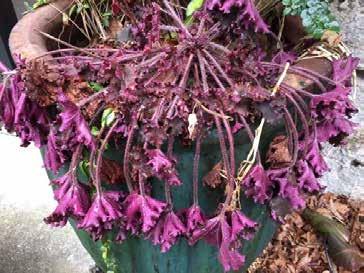
This little leaf miner has been around for years but rarely causes extensive damage. The diversity in home landscapes may provide a habitat for parasitoids that keep it in check. The wavy line between dark and light green is a skinny little mine. It may have skirted along the margin and caused the brown area at the tip. Pick off objectionable leaves. That refreshing blast of winter, froze camelia blossoms
This freeze damaged Heuchera should recover. Leaves may turn brown and crispy but if the stem hasn’t frozen it will revive to bloom another day. Cut off and brown leaves and hope for an early spring. In colder areas, the freeze may not have been so kind. Leaf spot fungi love salal. An OSU study of these leaf spots revealed a lot of fungi are thriving on salal. Even so by spring, in the wild and in gardens, salal looks better as the spring advances and new growth covers
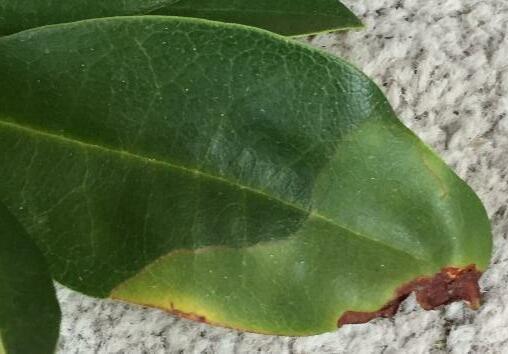
This little leaf miner has been around for years but rarely causes extensive damage. The diversity in home landscapes may provide a habitat for parasitoids that keep it in check. The wavy line between dark and light green is a skinny little mine. It may have skirted along the margin and caused the brown area at the tip. Pick off objectionable leaves. That refreshing blast of winter, froze camelia blossoms
Leaf spot fungi love salal. An OSU study of these leaf spots revealed a lot of fungi are thriving on salal. Even That refreshing blast of winter, froze camelia blossoms where so by spring, in the wild and in gardens, salal looks they bloomed. These will later turn papery and drop off. Other better as the spring advances and new growth covers blossoms not yet open are still green and look like they will open normally. Brown buds, not so much. Camellia will also abort buds in a freeze. Leaf spot fungi love salal. An OSU study of these leaf spots revealed a lot of fungi are thriving on salal. Even so by spring, in the wild and in gardens, salal looks better as the spring advances and new growth covers the damaged leaves. See details at https://pnwhandbooks.org/plantdisease/host-disease/ salal-gaultheria-shallon-leaf-spots Washington State Nursery & Landscape Association - 23
Journal of Environmental Horticulture Publishes Research on Impact of Temperature on Herbicide Activity
Weeds are arguably the most common pest problem in landscape management. Almost everyone can spot a weed, especially when it’s chickweed sticking out like a sore thumb in a stand of dormant bermudagrass in March.
Landscape managers face the challenge of scheduling a variety of activities and, as a consequence, can struggle to stay ahead of spring weed control. Often the first herbicide application is timed in conjunction with mulch laying, creating a labor bottleneck. One strategy to overcome this is to move herbicide applications from springtime to typically less-busy periods, such as late fall/early winter or late winter. This leads landscape managers to ask: do herbicides still work when applied in cool temperatures?
Research on just this subject was recently reported in the Journal of Environmental Horticulture (JEH), the publication of the Horticultural Research Institute. JEH is the only peer-reviewed, scientific journal dedicated to the green industry and serves as the outlet for research pertinent to our industry.
“In an already tight labor market, the importance of keeping up with the latest weed control research strategies regarding timing and efficacy of applications cannot be taken for granted by today’s landscape manager. In my role, I am very interested in the effects of temperature on weed control strategies, so that I can spread the traditional seasonal workload across twelve months in an attempt to retain more personnel year-round while improving quality and reducing potential overtime costs,” adds Joe Ketterer, Director of Quality and Efficiency with Ruppert Landscape.
Weed scientists agree that air temperature impacts how well an herbicide works. When applied during cool temperatures, herbicides generally do not work as well as when applied during warm temperatures. This is due to a few factors.
First of all, plants’ growth and metabolism slow dramatically in cool weather, which lessens herbicide absorption and translocation within the plant. Secondly, certain physiological changes occur in plants in response to cool temperatures. For example, the wax layer coating plant leaves gets thicker, which limits herbicide penetration (and ultimately efficacy). The increased wax layer also creates a hydrophobic environment, which decreases an herbicide’s leaf wetting capability.
Herbicide formulation merits a mention in this discussion as well, because it may overcome some of the above-mentioned impediments. Ester formulations, as opposed to amines, are more soluble in the plant cuticle – which means it

has a better chance of breaching a fortified wax layer – and are more easily absorbed by plants. Combining a contact herbicide (such as carfentrazone or sulfentrazone) with a systemic (such as 2,4-D or dicamba) is another tactic to increase weed control.
Dr. Jeff Derr, Virginia Tech, conducted a series of experiments that accounted for these variables. He assessed the impact of temperature on herbicide efficacy against winter annuals (ivyleaf speedwell, henbit, common chickweed, and purple deadnettle) in turfgrass (both cool and warm season varieties). Contact and systemic herbicide activity was compared alone and in premix combinations, and both ester and amine formulations were included. The following products were tested:
• Surge (sulfentrazone + 2,4-D, amine + MCPP + dicamba) • QuickSilver (carfentrazone) • SpeedZone Southern (carfentrazone + 2,4-D, ester + MCPP + dicamba) • PowerZone (carfentrazone + MCPA, ester + MCPP + dicamba) • SpeedZone (carfentrazone + 2,4-D, ester + MCPP + dicamba) • Trimec Classic (2,4-D, amine + MCPP + dicamba)
Study results prove valuable for landscape managers. “Control of winter weeds is an important concern for lawn care companies, golf course superintendents, sports turf managers, and others maintaining landscape areas. A concern in winter is the impact of colder air temperatures on the effectiveness of herbicides used for controlling emerged broadleaf weeds. Unless weeds need to be controlled very quickly, landscape managers have a wider window of opportunity to spray post-emergence broadleaf herbicides than previously thought,” said Dr. Derr.
Using a combination of contact and systemic herbicides, whether a custom tank mix blend or a premix product, increases the chances of winter annual weed control. Products containing carfentrazone (a contact) premixed with a systemic herbicide(s) controlled weeds better than a systemic applied alone. However, premix products in this study contained ester formulations, which also could explain the enhanced performance.
Following with previous studies, Dr. Derr concluded that temperature did affect herbicide activity. Overall, herbicide applications made during warmer temperatures (65° F), injured weeds faster than when made during cooler temperatures (45° F). However within three weeks after application, weed control was the same, regardless of whether applications were made during warm or cool temperatures.
If a landscape manager opts to prioritize speed of weed control, according to their customers’ preference, then herbicide applications should be made in warmer weather conditions. On the other hand if time management is a higher priority, herbicides can be applied during cooler weather, when more labor may be available. Selecting ester formulations and combining a contact with systemic(s) products may ensure greater success during cooler temperature applications.
For more information, please read the article in full at http:// hriresearch.org/images/HRI/PDF/JEH%2034-4-123-130.pdf.
Vernie Neal earned her wings and took off on a new adventure December 30, 2016.
She courageously battled Bulbar-onset ALS (Lou Gehrig’s Disease) with dignity and grace for over two years, and leaves behind her lifepartner/wife of 26 years, Gina McCauley (2000 WSNLA President), a loving family, and many industry colleagues who will miss her kindness, gentle spirit, professionalism, and incredible work ethic. Vernie worked in the Horticultural/Arboricultural field for over 30 years. She was a proud alum of Oregon State University, where she studied Forest Sciences and participated in basketball and volleyball. Although a quiet person, Vernie did have her “moments.” She famously led the ‘Red Bra Revolt’ in the early 80’s at the Carlton/Monrovia Nursery in Dayton, OR, where she was the only woman working in the can yards at the time. In 1986, Pruett Tree Service, Lake Oswego, OR hired Vernie as their first female fieldtechnician and she worked there for eight years while active in the Oregon Chapter of IPAA and serving on the Board of the Professional Women in Horticulture. Vernie and Gina met at a Women in Horticulture conference in January 1991, but didn’t make it official until meeting again at the Far West Show later that year. They maintained a long distance relationship until Vernie moved north from Portland in 1994 to care for her ailing mother, and to be closer to Gina. Vernie worked for Pete’s Spray Service, Puyallup, WA for three years before starting her final tenure at Davey Tree Expert Company, Bellevue, WA in January, 1997. While with Davey Tree, Vernie served on the Boards of the Washington Chapter of IPAA and PlantAmnesty. She led several seminar programs on application and pest management for the Seattle Chapter of WSNLA. She was an ISA Certified Arborist and maintained a CDL endorsement. Vernie was a gifted trainer, sales person, plant health technician, department manager, and a versatile go-to person for Davey Tree during the 18 years she worked there. Vernie will be remembered by many as a true professional, and as bit of a prankster and willing participant in some of the shenanigans at WSNLA conventions and other conferences. She will be greatly missed.
2017 WSNLA Chapter Activities
Mt Rainier Chapter
For more information or to be added to the email list to receive chapter meeting notice announcements, contact Ingrid Wachtler, Woodbrook Native Plant Nursery at woodbrk@harbornet.com.
Northwest Chapter
For more information or to be added to the email list to receive chapter meeting notice announcements, contact Toni Cross, CPH at toni@seasonalcolorpots. com.
Olympic Chapter
For more information or to be added to the email list to receive chapter meeting notice announcements, contact Gayle Larson, CPH at dancingravendesign@ gmail.com
Seattle Chapter
For more information or to be added to the email list to receive chapter meeting notice announcements, contact Kirsten Lints, CPH at kirsten@ gardenALIVEdesign.com.
Host or Sponsor a Chapter Meeting
Hosting a chapter meeting at your business is a great way to introduce your plant availability, products and services to potential clients and customers. By inviting nursery and landscape professionals to your business site, it provides an opportunity to share your expertise and build valuable relationships to grow your business.
CALENDAR OF EVENTS
Find more industry events at WSNLA.ORG!
MAY 14, FROM 10AM - NOON.
DIFFICULT PLANTS TO PRUNE. HOSTED BY PLANT AMNESTY. Location: Sand Point Magnuson Park (6344 NW 74th St - The Brig). This class teaches how to prune Rhododendron, Hydrangea, Callicarpa (Beautyberry), Viburnum bodnantense and Abelia. Included in this class are basic pruning techniques, common pruning mistakes and corrective pruning. Fee: $25 class, $20 for Plant Amnesty member. For more information contact info@plantamnesty.org or 206-783-9813
CPH Credit Available.
JUNE 15 & 16. ADVANCED BIOLOGICAL PEST MANAGEMENT FOR NURSERIES & GREENHOUSES A WORKSHOP AND EDUCATIONAL
TOUR. Hosted by Northwest Center for Alternatives to Pesticides Location: WSU Mount Vernon. CPH & ecoPRO
Credits Available. WSDA Pesticide Recertification Credits Pending. JUNE 2017 WSNLA LANDSCAPE DESIGN TOUR. LOCATION: GIG
HARBOR. COST: Earlybird registration before April 30. $65 Member, $85 Non Member. After April 30 $75 Member, $95 Non Member. CPH & ecoPRO Credits
Available.
JUNE 28. WSNLA BOARD OF DIRECTORS MEETING & TOUR.
Location: Wildhorse Renewal Energy Center in Ellensburg. All WSNLA
members welcome.
JULY 2, WSNLA OLYMPIC CHAPTER
MEETING. TOPIC: Landscape Equipment presented by ecoPRO Richard Hedahl, Hedahl Landscapes. Contact Megan Pullkinan at megancph@hotmail.com.
NOVEMBER 14-17, ecoPRO TRAINING &
EXAM. Location: Brightwater Treatment Plant, Woodinville. Learn more at www. ecoPROcertified.org.
WSNLA MARKETPLACE
PLANTS & TREES AVAILABLE
HOLLAND-AMERICA NURSERY. Now Available: Van den Akker weeping Alaska cedar 6’ thru 10’. Snowberry 1 gal. & 2 gal. Thuja plicata zebrina 5 gal. Red twig dogwood 1gal. Mahonia aquifolium 1 gal & 2 gal. Mahonia repens 1 gal & 2 gal. Mahonia aquifolium 5 gal. Rosa nutkana 1 gal. Rosa Rugosa 1 gal. English laurel 2 gal. & 5 gal. b&b. List available. (360) 794-6549, or akker4@gmail.com.
Specimen Street and landscape
Trees in large Root Control Bags. Year around availability, easier shipping, handling and establishment. Mount Vernon. (800) 827-4067. Fax (360) 4281822. www.urbanforestnursery.com.
WSNLA MEMBER.
Promote your job openings, plants and trees for sale, and other classified listings! Email your copy to breanne@wsnla.org.

Access a prequalified audience by posting your opening on the WSNLA Career Center. Your listings are promoted to over 2000+ nursery and landscape professionals. All listings are also promoted to the public. Please be sure to login to your WSNLA member account to ensure your special member rate. Non member rate is $35 per listing.

